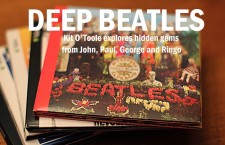Imagine being a teenager in the 1960s. Most likely, a Beatles album or two would have made an appearance under your tree. If you were an Official Beatles Fan Club member, however, you received a special stocking stuffer: the Beatles Christmas record, a yearly flexi-disc featuring holiday greetings from the Fab Four. From 1963-69, the group recorded personal messages, often accompanied by parodies of Christmas carols, in-jokes, promotions for upcoming releases, and heartfelt thanks to their fans.
While these records may have initially been seen as throwaways, today they reveal how the Beatles were evolving creatively, developing separate artistic identities, and were gradually drifting apart. In addition, these recordings provided a rare glimpse into their comedic roots, namely Liverpudlian humor and Goons-style banter.
The records were the brainchild of Tony Barrow, the Beatles’ PR man, who even wrote the liner notes for the sleeves. Accompanied by a club newsletter, the records were sent out to UK members from 1963-69. In the UK, the Christmas records were issued on flexi-disc, a seven-inch record made of very thin plastic.
As with most Beatles releases, the Christmas records were issued in a different order in the United States. Since the American fan club was not established until 1964, U.S. fans received the original 1963 record that year. According to the Beatles Rarity, this was sent on a “soundcard,” a postcard-size item that featured a turntable-friendly record on one side, the newsletter on the flip side. The 1965 record was skipped altogether, since the UK did not send it to America in time for the holidays.
By 1966, the U.S. edition of the Christmas messages were printed on a “soundsheet,” a large, very thin, and floppy plastic square. Similar to the “soundcard,” it contained the message on one side and the newsletter on the other. Interestingly, U.S. fans finally received the flexi-disc version by 1968. In the U.S. and UK, all flexi-discs were played at 33 1/3 rpm, with the exception of the short 1964 disc, which was played at 45 rpm.
When the Beatles split in 1970, US and UK fan club members received one last gift: an LP containing all of the Christmas messages. In the UK, the compilation was titled From Them to You; in the U.S., it was aptly named the Beatles Christmas Album. Other than those collections, the Christmas messages have never been officially re-released, although bootlegged editions have been available in physical form and online for many years.
Listening to the 1963-65 records, it is evident that the Beatles initially worked from Barrow’s scripts (even ridiculing the forced nature of the banter, as on the 1964 Christmas record), although they apparently improvised as well. In the early recordings, the Beatles let fans experience their camaraderie, eavesdropping on their private jokes and good-natured ribbing of each other.
John Lennon displayed his well-known love of word play and absurdist humor; George Harrison revealed his dry wit; Ringo Starr played the lovable life-of-the-party role; and Paul McCartney featured his typical “PR man” persona yet occasionally dropped his guard to reveal a streak of Lennon-esque humor.
Starting in 1966, the group abandoned the Barrow scripts and wrote their own material. This move resulted in stream-of-consciousness storytelling. Their nonlinear transitions predated Monty Python’s Flying Circus’ penchant for abruptly stopping skits and their brand of surrealist humor.
However, they also reflected the Beatles’ love for the Goon Show, a BBC radio program featuring Spike Milligan, Peter Sellers and Harry Secombe that aired from 1951-60. Sound effects, absurd plots, puns and a lack of clear segues into other sketches profoundly impacted the Beatles and Monty Python’s material.
In yet another Goon Show-Beatles connection, George Martin once helmed the troupe’s 1957 album Bridge On The River Wye. From 1966 until the final 1969 records, the Beatles delved further into surrealist humor and art, with Yoko Ono lending her avant-garde sensibilities to the final 1969 record.
The last two records demonstrated how they were developing their own interests and spending less time together. Unlike the earlier records, the four recorded their parts separately, and the sections were subsequently edited together. The disconnect showed, particularly on the 1969 recording featuring Lennon and Ono discussing their art, juxtaposed with the others delivering typical “Merry Christmas” greetings (with Starr particularly interested in promoting his appearance in the film The Magic Christian).
In 1968, Harrison thanked fans in a bored, perfunctory way and turned over the microphone to guest Tiny Tim, who launched into a strange version of “Nowhere Man.” It’s as if Harrison saw the writing on the wall and had already begun to disengage from the group, putting minimal personal effort into the Christmas record.
Listening to the Christmas discs sequentially not only entertains, but offers an audial presentation of the group members’ rapid artistic and personal development. Their interests matured and deepened, and their personal lives increasingly manifested themselves in their work.
From the boyish charm of the 1963 record to the fragmented and abstract quality of the 1969 disc (even down to the sleeve artwork), the Beatles continued to intrigue and challenge fans even with these seemingly “throwaway” releases.
- The Rescued Early Paul McCartney Song That Completed ‘Beatles For Sale’ - December 4, 2024
- A Rare Beatles Cover Proves John Lennon Was Wrong About His Voice - November 26, 2024
- How John Lennon Came Roaring Back on the Beatles’ White Album - November 22, 2023



Thanks. Great fun.